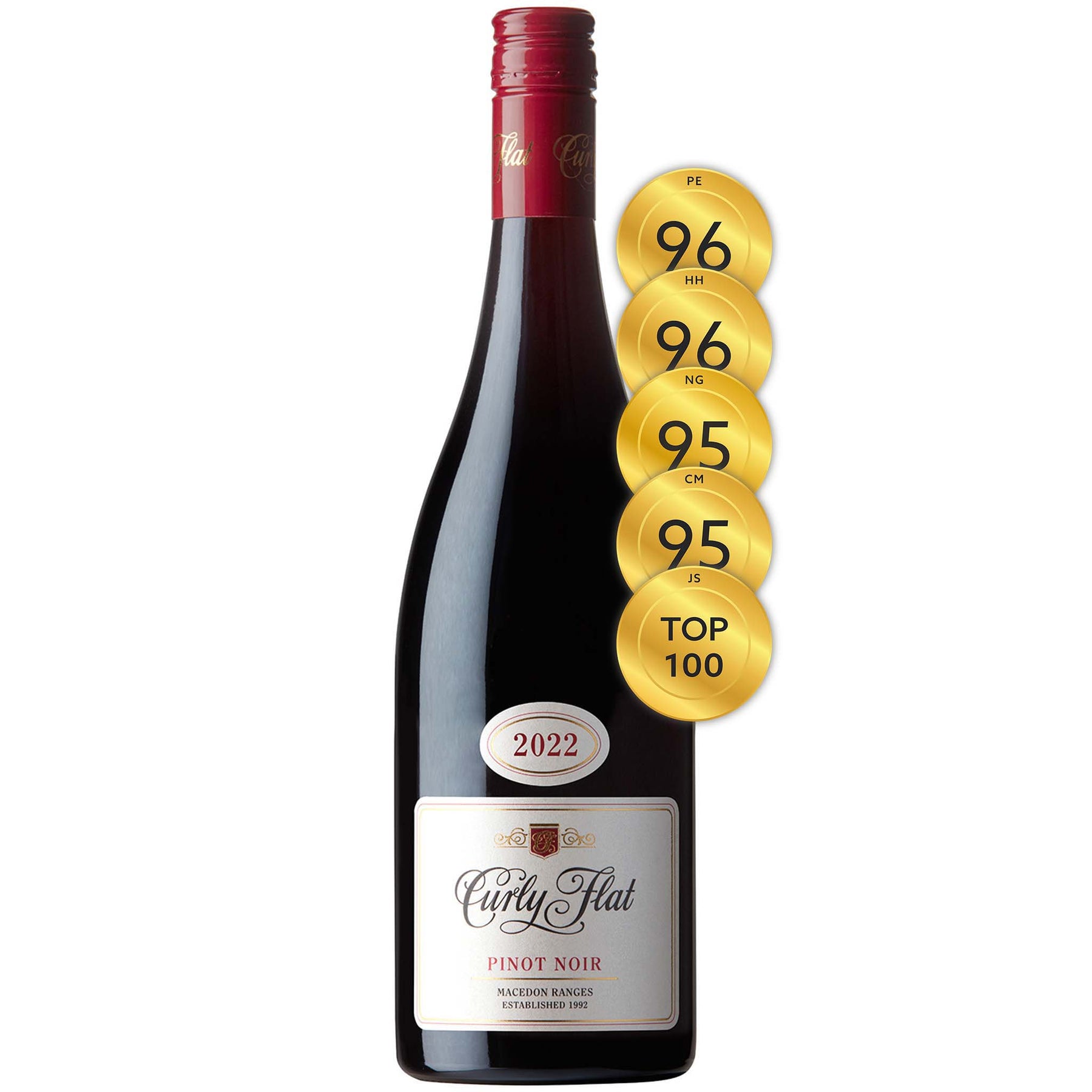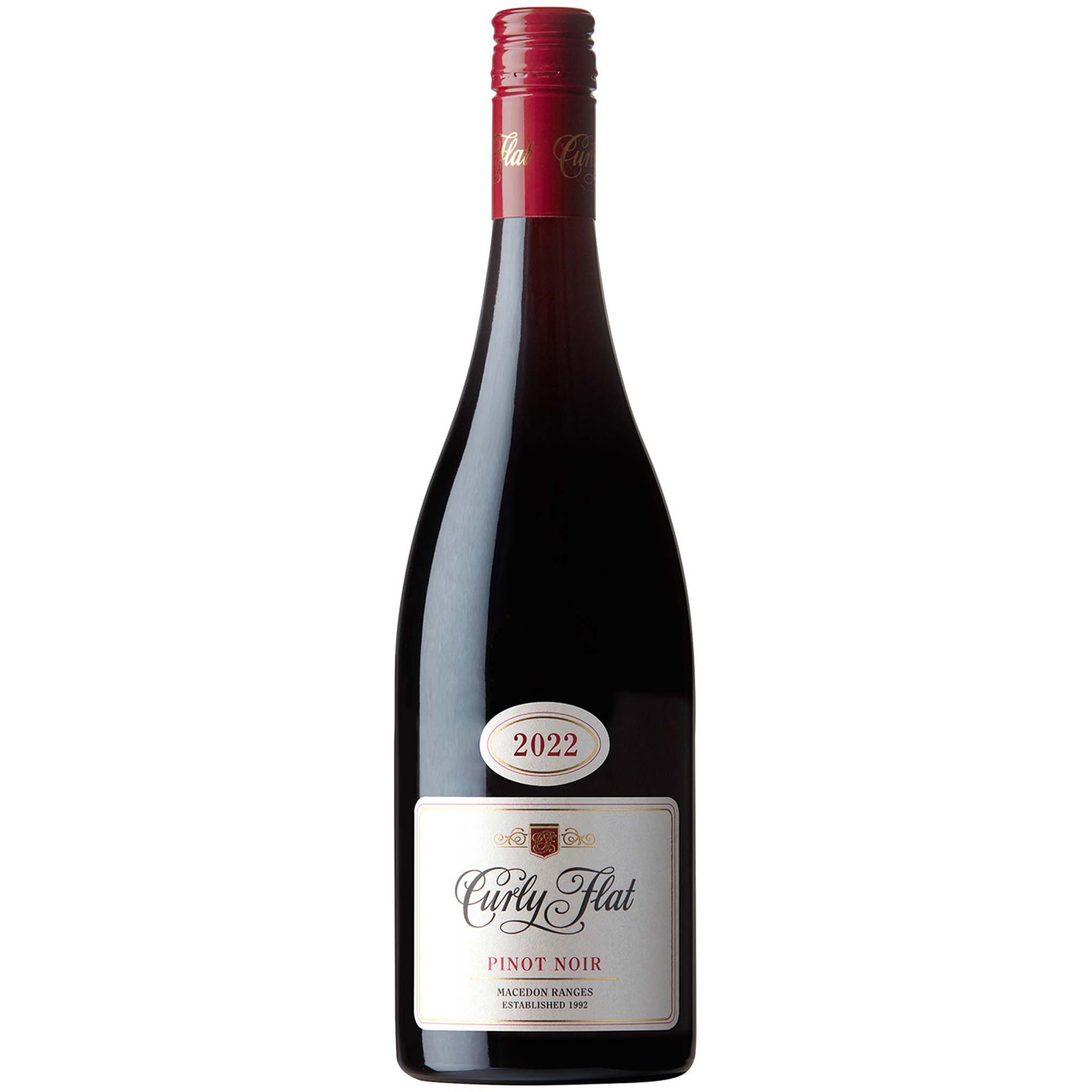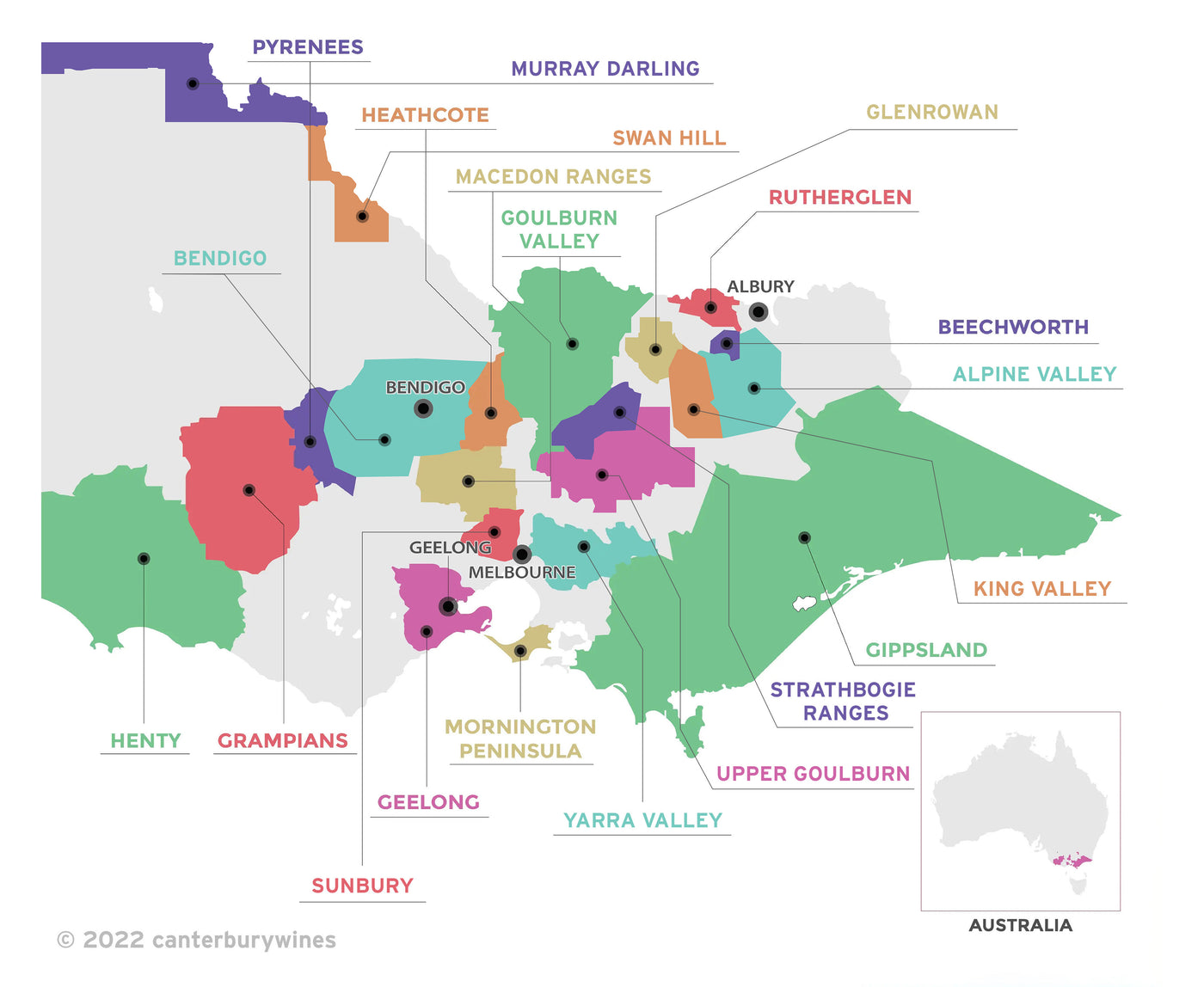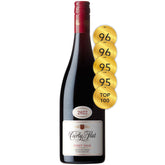

Curly Flat Pinot Noir 2022
Style: Red Wine
Closure: Screwcap
Curly Flat Pinot Noir 2022
Warehouse
34 Redland Drive
Vermont VIC 3133
Australia
Critic Score: 96
Alcohol: 13.5%
Size: 750 ml
Drink by: 2038
James Suckling Top 100 Wines of Australia 2024
The 2022 Curly Flat Pinot Noir is the fifth vintage with winemaker Matt Harrop in charge. The wine is a blend from the Central and Western blocks, planted from 1992 to 2000 and made up of clones 114, 115, D5V12 and MV6 – the famous Mothervine 6 that is said to have reached Australia in the 1830s from Burgundy. The blend consists of 6% whole bunches and was matured for 16 months in 17% new oak.
"Sweet cherry pinot varietal aromas, augmented by a little spice, the palate medium weight at most with lovely balance and effortless charm. A gorgeous pinot noir, with beautiful texture, line and length, everything in superb harmony. The most rounded and complete of the three Curly '22 pinots." Huon Hooke
"Our 2022 Estate Pinot Noir consists of eleven separate lots representing distinct aspects, clones and soils. Each of these parcels were handled with attention to vineyard details with the aim of maximising site expression. Indigenous yeasts connect all ferments but varying amounts of whole bunch, post ferment skin contact and individual oak handling were utilised respective to the lot characters themselves. Each of these parcels combine to form our most complex Pinot Noir, with fragrant spices and a red fruit lift that seamlessly merges with darker fruits and more savoury complexities. A myriad of vineyard based tannin entwines with gentle oak handling to accentuate a length of mineral clarity. After 16 months maturation our Estate blend consists of 6% whole bunch and 17% new oak and was bottled without filtration." Curly Flat
Expert reviews
"A beautiful release of Curly Flat that walks the line between being pretty and floral and that of a wine with latent power. The nose sees bright black cherry combining with wet earth and understated brown spice. The palate has black cherry from start to finish; there is a black tea influence and taut lines of acidity that afford the wine wonderful texture and length. There is a general coolness to the wine with fruit flowing effortlessly and textured detail that unfurls with time in the glass. Drinking well now but should be exceptional in time. Drink: 2024-2038." Patrick Eckel, Wine Reviewer – 96 points
"Bright medium-full red-purple colour; sweet cherry pinot varietal aromas, augmented by a little spice, the palate medium weight at most with lovely balance and effortless charm. A gorgeous pinot noir, with beautiful texture, line and length, everything in superb harmony. The most rounded and complete of the three Curly '22 pinots. Drink: 2024-2036." Huon Hooke, The Real Review - 96 points
"I like the stringiness of this, the tension, the fruit, the length. It’s real pinot. It feels as though it’s desperate to rush forward but it holds itself back until it gets to the finish, where it runs. It has a minerally aspect, a sour ripeness, a thread of woodsmoke, a garni of herbs. It will cellar beautifully. It’s cool, ripe, savoury, seamless and long.
I tasted the three Curly Flat 2022 Pinot Noirs masked and for this one I wrote: The most complete of the three. Given that they’re all excellent quality, that may be all that you need to know." Campbell Mattinson, The Wine Front - 95 points
"This wine delivers ample reason for intrigue. Red cherries, musk, root spices and warming notes of shiitake mushrooms, dashi and undergrowth, conferring depth and ample, medium-bodied complexity. The tannins are chewy and satisfying, yet in need of resolution. Spicy and firm. This stands to age well. Drinkable now, but best from 2026. Screw cap." Ned Goodwin MW, JamesSuckling.com - 95 points and Top 100 Wines of Australia 2024
Awards
James Suckling Top 100 Wines of Australia 2024
Matt Harrop

The text below is taken from an article by Huon Hooke that appeared in The Real Review
I met with owner Jenifer Kolkka soon after Matt Harrop (ex-Shadowfax) had taken the reins at Curly Flat, and she could not disguise her excitement. Speaking again last week, her enthusiasm for the future of Curly Flat was undiminished.
"Matt is so hands-on, both in the vineyard and the winery," she enthused.
"He even tops the barrels up with Ben (Kimmorley, assistant winemaker). Every barrel gets that individual attention. We used to always give the pinot noir 20 months in oak, but when Matt took over the 2017 pinot was in barrel, and it was a big vintage so there were a lot of new barrels, and he went through all the barrels and took a lot of the wines out of the new oak and put them in older, neutral oak because it’s a delicate year and he didn’t want the new oak to crush the delicate fruit."
She says Harrop gets out in the vineyard and prunes with the rest of the crew, and gets the team in at least four times a year to show them how the wines are progressing, and show them how different pinot noir can be from different parts of the vineyard.
Another Harrop change has been frost control. Curly Flat has a great supply of water, from a massive 20-megalitre dam (which covers four acres), as well as a bore supplying high-quality water.
Until Harrop arrived, frost was controlled with a sprinkler system, but he discovered that too much water was going into the soil, so he installed frost fans and turned the water off. Then he found that due to soil variation, some parts of the vineyard weren’t getting enough water, so he installed soil moisture probes. Now irrigation is managed specifically for each part of the vineyard.
Another change is with the second label, Williams Crossing.
"No more Williams Crossing," says Jeni Kolkka.
"We used to treat all of the fruit the same as it came out of the vineyard. The best wine went into Curly Flat, the rest went into Williams Crossing. Matt decided that if it doesn’t make it into Curly Flat it goes into White Pinot (a rosé style), which sells like hot-cakes. No oak. It sells in the year of making so it’s quick turnover and good for cash-flow."
And the wine is delicious, incidentally.
Harrop, who also owns a vineyard in the Macedon area with his wife Tamara Grischy (head of Langton’s Fine Wine Auctions), started at Curly Flat in October 2017. He finished the 2017 vintage wines and oversaw the bottling of the 2016 pinots, but 2018 was his first complete vintage.
Harrop was asked in April 2024: "Is there one thing that you wouldn’t have done, if you could go again?
"Oh God, there’s about 5000 things. I would have spent more time in the Northern Hemisphere sucking up a little bit of what they’re doing there. I haven’t done enough of that. Not a flying winemaker job. Just going in and talking to people – like you’re doing here today. We’ve got access to a lot of wine over here now, but things were different twenty years ago.
From a winemaking point of view – maybe wouldn’t have farmed in Heathcote for ten years, like I did at Shadowfax. I’m glad I’ve got regrets about what I have done, rather than what I haven’t done.
With regards to Curly Flat, one thing we will do is slowly converting things over to VSP. Whether we top-work stuff like we’ve done in the past and re-trellis. It is a ten-year project.
Stepping back and looking at wines from 2020… one of the things we love about the ‘20s is that they talk a little bit more about the earth rather than the sky. One of the massive limiting factors in this part of the world is that big orange ball in the sky. It’s a strong influence. If there’s one thing that can obscure where a grape is from, it is too much sun. The 2020 is savoury tannins, more earthy and quite reserved. We think there is a Curly Flat theme. One of the things that shits me about the Aussie industry is that our 'most important producers', the Penfolds of the world, are actively working to persuade people that vintage variation doesn’t exist. The rest of us think it’s really important to say to people that wine is not the same every single time. That’s part of the pleasure of it."
About the winery

Curly Flat, a small privately owned vineyard and winery in the Macedon Ranges, was founded in 1989 by Phillip Moraghan and Jenifer Kolkka. The Macedon Ranges is the coolest viticultural area on mainland Australia and the Curly Flat Vineyard has proved to be ideal for growing the early ripening varieties of pinot noir and chardonnay.
The first vines were planted in 1991 but problems with clonal identification and quality of planting material resulted in these vines being removed. The hard work of planting was repeated in 1992. Subsequent plantings (1993 to 2000) have seen the vineyard grow to 14.5 hectares. The majority of the area is planted to Pinot Noir (72%), with smaller plantings of Chardonnay (23%) and Pinot Gris (5%).
The Curly Flat Vineyard is acknowledged as the greatest influence on wine quality. This unique viticultural site owes much to the combination of altitude (540 metres), latitude (south of The Great Dividing Range), and distance from the mitigating influence of the ocean. A diversity of aspect and clone provide multifaceted winemaking opportunities. The climate is ideal for growing Pinot Noir and Chardonnay - warm summer days, then crisp, cool evenings which slow ripening and produce fruit of high natural acidity and intense flavour. The red volcanic basalt soils have structure and depth allowing the roots to descend many metres, increasing the soil volume able to be exploited by the vines.
In 2006 Curly Flat ceased using herbicides and have seen a marked improvement in soil microfauna. The resulting increase in organic matter has been staggering and bodes well for the future health of the vines.
Curly Flat wines are naturally fermented; the use of ambient yeast (those that are native to the vineyard and winery) leads to improved texture, mouthfeel and more varietal flavour components in the wines.
In 2017, Jenifer accepted Phillip's offer to take over sole ownership of Curly Flat. Under her leadership, the winery's reputation for high-quality winemaking continues. Jenifer and her team, led by new winemaker Matt Harrop, are fully committed to producing the best possible wines from their carefully nurtured site.
The Vineyard

Curly Flat Vineyard Plantings
"We’ve got about 15 hectares under vines, starting with a block of Pinot Noir planted in 1992. Followed by Chardonnay in 1993; then at the top of the hill there’s Pinot Noir from ’95 and ’96. What we refer to as our 'Western' plantings were in 1997 and ’98. The big block was planted in 2000, and every year we’ve progressively planted more.
We are about 70% Pinot Noir, 25% Chardonnay and 5% Pinot Gris. There’s a massive thirst for Pinot – especially in Melbourne. It’s very parochial down there, and we have an advantage over most other winegrowers in Australia, as we can ripen Pinot. We’re quite continental here – a long way from the sea. We farm very simply and have this mix of young and old vines. We shoot-thin in the Spring and there’s a lot of natural crop control, because we are a frosty site.
The winery was built in 2002, we farm sustainably here, but not organic. In a year like this, you hear stories from places like Heathcote where they haven’t got fruit. We haven’t used any herbicide here since 2006, and we like the effect we get from just mowing underneath the vines. That works for us – keeps the disease pressure down. We do get a bit of botrytis in the Chardonnay, but I don’t think a little bit is a bad thing.
With our geology, it is quite similar across the site – degraded basalt – but we’ve got this 430-million year old devonian-era sands up here, which we found after a soil survey in 2019. Our 'Western' plantings have an easterly aspect – so morning sun. They don’t get the afternoon sun, so are the coolest slopes in the vineyard. Quite supple, textured, aromatic, and by 2018 we thought 'these look really different to everything else we’ve got' and we now bottle the 'Western' individually. Initially a blend of two blocks and two different clones, in 2018 to 2020. And now, we’ve got seven rows of clone 114 that we’ll do separately.
'Central' is from the oldest vines in the place – MV6 clone from 1992. I really like MV6. They reckon James Busby brought it over from Clos du Vougeot in the 1830s. That’s north-facing so it cops the afternoon sun. Much smaller berries and smaller bunch architecture. More tannin and very musky red fruit. There’s a bit of it in NZ, but they don’t like it over there. I think it’s genetically modified itself over here, to suit what happens here.
Same can be said for Abel – I’ve yet to try an Australian Abel wine where I’ve gone 'well that’s better than everything else'. It works well in Martinborough but they’re not such fans of it in Central Otago. That whole clonal thing is really interesting. I read and see about people who I respect in other parts of the world, where the clonal debate has taken a back seat. We’ll be taking some cuttings from our 1992 MV6 and cultivating from that, to plant the place with.
Historically our Pinot Noir has been planted at 3.2 by 1.8 metres in a lyre trellis. Today we are planting at 2.2 by 900, which we really like. We won't be doing high-density planting like over at Bindi. I think that after 30 years in the ground here, Pinot has this ability to adapt to site. I take my hat off to anyone, like Michael, who is doing that density of planting, but I see it fraught with all sorts of things. I have too many questions about it. There were cultural reasons why it occurred over in Burgundy. Winemaking, grape growing – it’s a commercial pursuit. And it’s expensive to put a vineyard in anyway, so three times more expensive to put a close-planted vineyard in." Matt Harrop - from an interview with David Walker Bell that appeared in WineFolio

Victoria
Victoria is home to more than 800 wineries across 21 wine regions. The regions are Alpine Valley, Beechworth, Bendigo, Geelong, Gippsland, Glenrowan, Goulburn Valley, Grampians, Heathcote, Henty, King Valley, Macedon Ranges, Mornington Peninsula, Murray Darling, Pyrenees, Rutherglen, Strathbogie Ranges, Sunbury, Swan Hill, Upper Goulburn and Yarra Valley.
Victoria's first vines were planted at Yering in the Yarra Valley in 1838. By 1868 over 3,000 acres had been planted in Victoria, establishing Victoria as the premier wine State of the day. Today, the original vineyards planted at Best's Wines are among the oldest and rarest pre-phylloxera plantings in the world.
Victoria's climate varies from hot and dry in the north to cool in the south and each wine region specialises in different varietals. For example, Rutherglen in the north is famous for its opulent Muscats and Topaque and bold reds, while the many cooler climate regions near Melbourne produce world class Chardonnay and pinot Noir. Victoria is truly a wine lover's playground.

